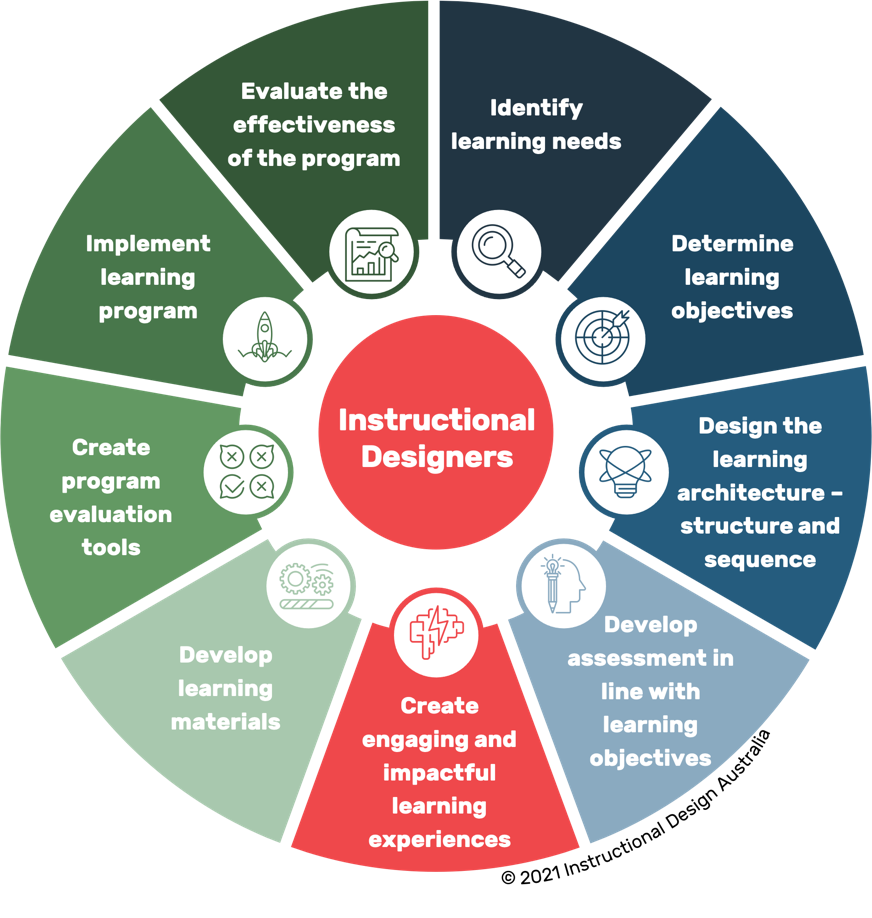How to Become an Instructional Designer
What do Instructional Designers do?
Instructional Designers draw on their understanding of how adults learn to inform decisions on the creation of instructional materials. They use instructional design principles, such as Merrill’s First Principles of Instruction, to create effective learning experiences.
In an end-to-end project, Instructional Designers:
- Identify learning needs
- Determine learning objectives
- Design the learning architecture – the structure and sequence of learning experiences
- Develop assessment in line with learning objectives
- Create engaging and impactful learning experiences
- Develop learning materials – facilitator guides, workbooks, PowerPoints, handouts etc.
- Create program evaluation tools
- Implement the learning program (typically IDs with handover to facilitators to deliver the program, however some IDs also deliver training)
- Evaluate the effectiveness of the program
What skills do Instructional Designers need?
Instructional Designers need to know how to effectively apply adult learning principles and follow instructional design models to develop impactful learning programs. They must be proficient in completing each of the tasks listed above.
What makes an Instructional Designer ‘exceptional’?
The following ‘soft skill’ and attitudes set Instructional Designers above the rest.
Why become an Instructional Designer?
Instructional Design is a fulfilling career – not only do IDs help others to learn and improve business outcomes, but they also continuously develop their own capabilities with each new project, as audience learning needs differ.
Here are some key reasons why Instructional Designers love what they do:
- Diverse projects keep things interesting. A wide range of subject matter, working with a variety of clients, and designing for various delivery methods and learning methodologies keeps an ID challenged and engaged
- Continuous learning opportunities to grow and learn new skills e.g. specialise in eLearning or accessible learning, improve your digital design skills, apply the latest ‘learning trends’ etc.
- Shape people’s attitudes towards learning – foster a love for learning
- Set learners up for success
- Help to achieve business objectives
- Assist in creating a safe, efficient and productive work environment
Many Instructional Designers also have flexible work hours and work from home.
How to become an Instructional Designer
Although you don’t require a specific qualification to become an Instructional Designer, you should complete an instructional design course to develop an understanding of how people learn and what that means when designing learning.
Instructional design courses will cover different instructional design models, such as:
- The ADDIE Model
- Merrill’s First Principles of Instruction
- Bloom’s Taxonomy
- Gagne’s Nine Events of Instruction
Instructional Design Australia offer a range of online and face-to-face courses to learn the basics of instructional design. On enrolment, learners are provided with access to a toolkit of guides and templates that they learn how to use during the course. Learners have lifetime access to the templates, with an included licence in perpetuity.
Learn more
Select the links below to learn more.
- Instructional Design Courses
- How to Become an Instructional Designer
- Do You Need an Instructional Design Degree?
- What is Instructional Design?
- What Do Instructional Designers Do?
- Do You Need an Instructional Design Degree Qualification?
- Merrill’s Instructional Design Principles
- What is the ADDIE Model of Instructional Design Anyway?!
- Instructional Designer




